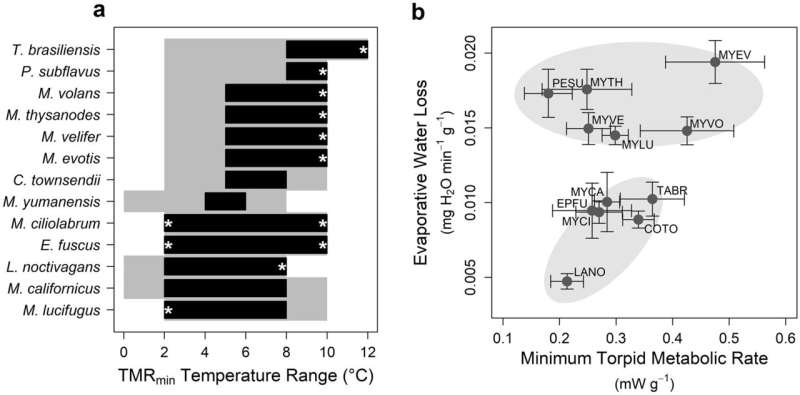Variation in temperature responses, minimum torpid metabolic rate (TMRmin), and evaporative water loss (EWL) among species. (a) Minimum defended temperature and the range of temperatures which resulted in TMRmin varied among species. Gray area represents the temperature range over which the species was tested, the black bars represent the temperature range over which TMRmin was measured. The lower end of the black boxes represents the estimated minimum defended temperature, but note that asterisks highlight cases where the TMRmin temperature range reached either the upper or lower limit of the tested temperature range. (b) Within the range of temperatures at which TMRmin was measured, evaporative water loss (EWL) varied among species (high and low EWL clusters) but not TMRmin. Error bars indicate standard error and gray ovals are presented for visual interpretation. Credit: DOI: 10.1038/s41598-021-00266-x
When it comes to hibernation, conserving resources is key for an animal's survival. For bats of Western North America, water may be the key to assessing a bat species' ability to thrive during hibernation.
New research that comes as part of a larger project to understand the differences between bats on the East and West coasts of North America also found that bats are adept at finding similar hibernation conditions across their large geographic ranges, despite a variety of climates in these areas.
"Understanding the differences, hibernation patterns and physiology of bats in the West is key to predicting the impact that climate change and diseases such as white-nose syndrome will have on these bats," said Liam McGuire, a biology professor at the University of Waterloo who led the bat hibernation patterns and physiology portion of this project.
"White-nose syndrome has devastated bat populations in Eastern North America in recent years but has not yet reached the bats of the West. Understanding the bat's hibernation patterns can inform prevention and conservation efforts as this disease spreads west."
Since a single bat species can have a habitat range spanning over 1,200 kilometers, the team first collected measurements on two different species of bats throughout their ranges—Northwest Territories to Montana and British Columbia to Colorado. Despite vastly different climates found throughout these ranges, within the same species, bats were able to find remarkably similar roosting conditions and did not have significant variations in bodily functions during hibernation.
The researchers then expanded their research to compare the hibernation patterns of 13 different species of bats. While bat species were consistently able to maintain energy levels and metabolisms during hibernation, differences appeared when comparing the amount of water that different species lost as they hibernated.
"Water is a crucial resource for survival. Bats that lose high amounts of water through their skin or in their breath may need to arouse more frequently to drink water, impacting their hibernation cycles and requiring more energy overall."
This water loss may be the key to understanding the impact of white-nose syndrome in bats. Although the disease has not reached the western bats studied, McGuire's team observed that, among bats that live across the entire continent, the bat species with high water loss are the ones most heavily impacted by white-nose syndrome along the East Coast.
The papers, "Interspecific variation in evaporative water loss and temperature response, but not metabolic rate, among hibernating bats" and "Similar hibernation physiology in bats across broad geographic ranges" were recently published in Nature's Scientific Reports and the Journal of Comparative Physiology B, respectively.
More information: Liam P. McGuire et al, Interspecific variation in evaporative water loss and temperature response, but not metabolic rate, among hibernating bats, Scientific Reports (2021). DOI: 10.1038/s41598-021-00266-x
Liam P. McGuire et al, Similar hibernation physiology in bats across broad geographic ranges, Journal of Comparative Physiology B (2021). DOI: 10.1007/s00360-021-01400-x
Journal information: Scientific Reports
Provided by University of Waterloo
























